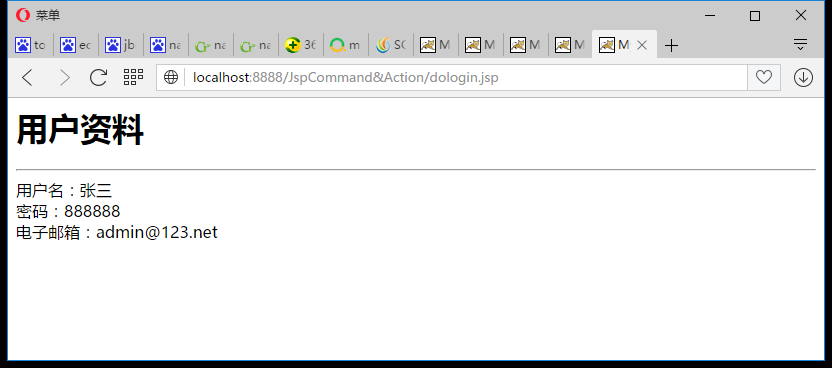JSP中param动作的实例详解
更新时间:2017年10月12日 09:44:31 作者:cakin24
这篇文章主要介绍了JSP中param动作的实例详解的相关资料,希望通过本文能帮助到大家,需要的朋友可以参考下
JSP中param动作的实例详解
一 语法
<jsp:param name="参数名" value="参数值">
常常与<jsp:forward>一起使用,作为其子标签存在。
二 代码
1、login.jsp
<%@ page language="java" import="java.util.*" contentType="text/html; charset=utf-8" %>
<%
String path = request.getContextPath();
String basePath = request.getScheme()+"://"+request.getServerName()+":"+request.getServerPort()+path+"/";
%>
<!DOCTYPE HTML PUBLIC "-//W3C//DTD HTML 4.01 Transitional//EN">
<html>
<head>
<base href="<%=basePath%>" rel="external nofollow" rel="external nofollow" rel="external nofollow" >
<title>My JSP 'login.jsp' starting page</title>
<meta http-equiv="pragma" content="no-cache">
<meta http-equiv="cache-control" content="no-cache">
<meta http-equiv="expires" content="0">
<meta http-equiv="keywords" content="keyword1,keyword2,keyword3">
<meta http-equiv="description" content="This is my page">
<!--
<link rel="stylesheet" type="text/css" href="styles.css" rel="external nofollow" rel="external nofollow" rel="external nofollow" >
-->
</head>
<body>
<h1>系统登录</h1>
<hr>
<form name="loginForm" action="dologin.jsp" method="post">
<table>
<tr>
<td>用户名:</td>
<td><input type="text" name="username"/></td>
</tr>
<tr>
<td>密码:</td>
<td><input type="password" name="password"/></td>
</tr>
<tr>
<td colspan="2"><input type="submit" value="登录"/></td>
</tr>
</table>
</form>
</body>
</html>
2、dologin.jsp
<%@ page language="java" import="java.util.*" contentType="text/html; charset=utf-8"%>
<%
String path = request.getContextPath();
String basePath = request.getScheme()+"://"+request.getServerName()+":"+request.getServerPort()+path+"/";
%>
<!DOCTYPE HTML PUBLIC "-//W3C//DTD HTML 4.01 Transitional//EN">
<html>
<head>
<base href="<%=basePath%>" rel="external nofollow" rel="external nofollow" rel="external nofollow" >
<title>My JSP 'dologin.jsp' starting page</title>
<meta http-equiv="pragma" content="no-cache">
<meta http-equiv="cache-control" content="no-cache">
<meta http-equiv="expires" content="0">
<meta http-equiv="keywords" content="keyword1,keyword2,keyword3">
<meta http-equiv="description" content="This is my page">
<!--
<link rel="stylesheet" type="text/css" href="styles.css" rel="external nofollow" rel="external nofollow" rel="external nofollow" >
-->
</head>
<body>
<jsp:forward page="user.jsp">
<jsp:param value="admin@123.net" name="email"/>
<jsp:param value="888888" name="password"/>
</jsp:forward>
</body>
</html>
3、user.jsp
<%@ page language="java" import="java.util.*" contentType="text/html; charset=utf-8"%>
<%
String path = request.getContextPath();
String basePath = request.getScheme()+"://"+request.getServerName()+":"+request.getServerPort()+path+"/";
%>
<!DOCTYPE HTML PUBLIC "-//W3C//DTD HTML 4.01 Transitional//EN">
<html>
<head>
<base href="<%=basePath%>" rel="external nofollow" rel="external nofollow" rel="external nofollow" >
<title>My JSP 'user.jsp' starting page</title>
<meta http-equiv="pragma" content="no-cache">
<meta http-equiv="cache-control" content="no-cache">
<meta http-equiv="expires" content="0">
<meta http-equiv="keywords" content="keyword1,keyword2,keyword3">
<meta http-equiv="description" content="This is my page">
<!--
<link rel="stylesheet" type="text/css" href="styles.css" rel="external nofollow" rel="external nofollow" rel="external nofollow" >
-->
</head>
<body>
<h1>用户资料</h1>
<hr>
<%
request.setCharacterEncoding("utf-8");
String username = "";
String password = "";
String email = "";
if(request.getParameter("username")!=null)
{
username = request.getParameter("username");
}
if(request.getParameter("password")!=null)
{
password = request.getParameter("password");
}
if(request.getParameter("email")!=null)
{
email = request.getParameter("email");
}
%>
用户名:<%=username %><br>
密码:<%=password %><br>
电子邮箱:<%=email %><br>
</body>
</html>
三 运行结果

如有疑问请留言或者到本站社区交流讨论,感谢阅读,希望能帮助到大家,谢谢大家对本站的支持!
相关文章

详解Hibernate cascade级联属性的CascadeType的用法
这篇文章主要介绍了详解Hibernate cascade级联属性的CascadeType的用法的相关资料,需要的朋友可以参考下2017-02-02












最新评论